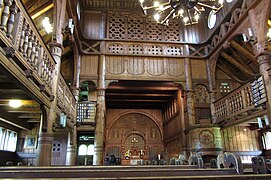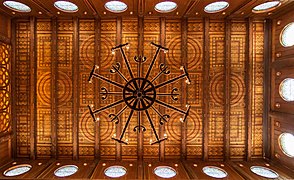Gustav Adolf Stave Church
The Gustav-Adolf-Stave Church is a stave church in the Goslar district of Hahnenklee-Bockswiese in the Harz Mountains .
The building is a free replica of Borgund stave church . Some adaptations were necessary so that 350 seats can be accommodated in the church. Construction of the church began in 1907 and was consecrated on June 28, 1908.
history
Until the beginning of the 20th century, the attic of the school building at that time near today's Hindenburgplatz served as a church service room. With increasing tourism, this area became too small, especially during the summer months.
Therefore the consistorial architect Karl Mohrmann from Hanover was commissioned to design an independent church building for Hahnenklee. During a study trip to Norway, Mohrmann had seen the stave churches there and signed some of them. He suggested building a stave church in Hahnenklee, justifying this, among other things, with the fact that at the time of the Christianization of Germany there were stave churches in all of northern Germany and this architectural style was therefore also at home here.
In the years 1907 to 1908, Hahnenklee craftsmen built the Hahnenklee stave church from spruce wood cut on the north side of the Bocksberg . Although it is a replica or an imitation of the original stave churches, which are over 800 years old, their unusual appearance contributes to their high level of awareness. In contrast to the Hahnenklee stave church, the Norwegian stave churches are much smaller (approx. 50 seats) and very dark inside due to the lack of larger windows.
At first, the chancel could be separated with movable walls and used as a winter church.
The Hahnenklee stave church has been extensively renovated several times, with the appearance of the facade having changed. The last, very complex renovation was carried out between 2000 and 2006.
organ
Equipping the stave church with an organ was difficult due to the special climatic conditions in the Harz Mountains and in the wooden church. At first there was only one harmonium available. In the mid-1950s, an electro-pneumatic cone chest organ consisting of 1,600 pipes and 26 registers was installed. This was expanded in the mid-1980s because it was often out of tune and maintenance was expensive.
After having made do with an electronic organ for a few years, the Goll company installed a new organ in 1994 , which has 27 stops on two manuals and a pedal and is provided with a mechanical playing and stop action. The organ pipes are hidden above the sanctuary behind a serpentine grille; the gaming table is on the gallery level to the left of the sanctuary.
In 2014 another register was added to the organ. It is one of the few organs to have a nightingale register.
Carillon
Since 1976 there has been a small carillon in the roof turret of the church. It comprised 18 bronze bells from the Heidelberg bell foundry Schilling . These bells are cast in what is known as the extremely heavy, much appreciated Schilling rib . Friedrich Wilhelm Schilling intended the game for his workshop. He died before it was completed. It could be acquired for the stave church from his estate. Due to technical defects, the carillon fell silent in 2000. As part of the pending restoration work on the tower with the chime bells, the possibility of relocating this game to the tower room of the tower and its extension arose from 2001: In a first phase with the inauguration at Pentecost 2002 on 2 Octaves with the 18 old, the 5 new bells and one of the four chime bells as well as a second phase with the inauguration at Pentecost 2005 to 4 octaves supplemented by another 25 new bells. The range of the manual runs from b1, c2, d2 in chromatic steps to c6 and the pedal from b1, c2, d2 to g3. The construction and installation of the extended glockenspiel was carried out by Otto Buer from Neustadt in Holstein. The new bells were cast by the bell foundries Schilling from Heidelberg and Perner from Passau
Others
Since the original stave churches were built in the time of Christianization, they still contain pagan symbols such as dragon heads or snake symbols. These can also be found in abundance in Hahnenklee. There are parallels with shipbuilding: Since the first stave churches were built by the Vikings, they adopted elements of shipbuilding. The roof structures in particular have similarities with an upside-down Viking ship. In the Hahnenklee stave church, the chandelier was modeled on a ship's steering wheel in memory of this connection, and the upper windows resemble portholes . During the last renovation, dragon heads were installed on the roof ridge like those used as bow figures on Viking ships.
In the 1960s and 1970s in particular, the stave church was a popular wedding church. In record years, there were 300 weddings a year.
The location of the church was a compromise between the two districts of Hahnenklee and Bockswiese of what was then the municipality of Bockswiese-Hahnenklee (from 1935: Hahnenklee-Bockswiese). The church was placed on the outskirts of Hahnenklee, which was closest to Bockswiese. In the 1950s, the school was built 200 meters south at a similar “central” location.
Partner church
Partner Church of Gustav Adolf Stave Church is the 12th - 13th century in Norway Vang erected Wang Church , set against a planned demolition by the Prussian king in 1841 Friedrich Wilhelm IV. Acquired and Brückenberg (now Karpacz Górny ), now the district of Karpacz (today Karpacz ) in the Giant Mountains was rebuilt.
Interior views
Web links
Individual evidence
- ↑ Internet pages of the parish
- ^ Hahnenkleer Carillon. Retrieved October 27, 2018 .
- ↑ OTTO BUER: Carillon. Retrieved October 27, 2018 .
- ↑ Perner bell foundry. Retrieved October 27, 2018 .
- ↑ Wang Church at www.stabkirche.de
Coordinates: 51 ° 51 ′ 25 ″ N , 10 ° 20 ′ 24 ″ E







